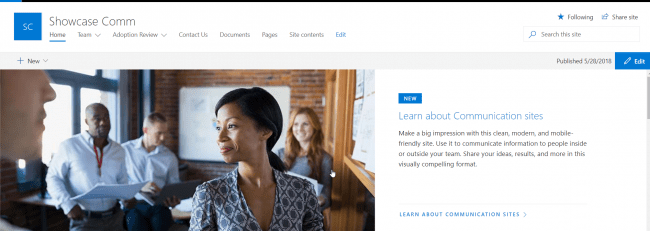
With the modern responsive design and full-page layouts, Communication sites are an ideal candidate for Intranet sites. During last few projects, we have implemented Modern Intranet portals using Communication Sites and found that user adoption was exceptionally high. We also gained a lot of experience from these implementations, which I will be sharing here.
Note: Most of the below features and advancements are of during Oct 2018, there are few major releases from Ignite 2018 which be released later. I will be providing more information on them in upcoming blogs.
Before we start discussing about the planning and implementation steps, lets’ look at some of the advantages of Communication sites.
- Modern page authoring and easy metadata management
- Responsive full-page layout and design
- Modern configurable and responsive web parts
- Easy content sharing and collaboration feature
- Modern libraries, content filtering and filtering features
Planning:
It is important to plan the Modern Intranet as per requirements for the business. Some of the key elements could be:
- Owner and Collaborators – These are key stakeholders and will need to onboard prior to the release
- UX/UI Design components – This is really important for a good usability and user flow. An important point to note is that the not everything in SharePoint Modern Site customisable, so it will be important to involve a SharePoint Technical person too for this.
- Customizations required – These are solutions that fall out of scope of SharePoint online existing or OOB functionalities. For eg. custom webparts, header or footer components, custom pages, and workflows. Again a SharePoint technical team member will be helpful to identify these.
- Training and Support – These are critical for a good adoption of the platform with it goes live.
- Feedback sessions – It would be important to plan these sessions with the key stakeholders before final handover.
Implementation:
The steps for implementation would be at high level as below:
1. Home page layout and component
The Home page is one of the most visited pages in the Intranet and hence needs to be planned thoroughly. Try mix and match options with various web parts such as Hero web parts, Yammer, Highlighted content, News content etc.
2. Site and Content Pages implementation
The next important bit is to create content pages and site pages that distribute content across the Intranet. It is important to use a consistent concept across these pages so that teams can find it easy to use. Most of the successful components in this area are:
- Highlighted content web part
- Document library web part
- Text
- Quick Links (with image preview) etc.
For custom page creation and content approval flow process, please check the blog here. Also in an upcoming blog, we will look at how to use OOB Page approval flows for implementing page approvals with site pages.
3. Ease Metadata management
Metadata management is taking a next leap with modern pages and libraries. We can now set a page metadata on a page itself by editing which is quite cool as the authors don’t have to go searching for the Pages library to edit metadata.

Also there is a page details web part of you would like to show the metadata on the page.
4. Apps
Apps play an important role in an Intranet too. All the corporate, admin and IT forms can now be integrated into the modern pages seamlessly using PowerApps or custom build SharePoint Framework solutions.
Also an important component for a new Intranet would be to get feedback on it. Use a Microsoft Forms survey for to capture the feedback.
Conclusion
The above is a quick overview of Communication sites as Modern Intranet. Please keep an eye for more upcoming blogs on more technical details.
